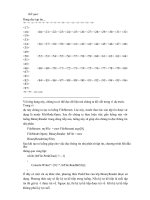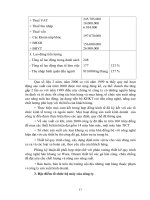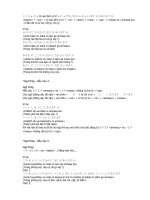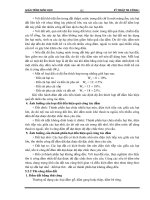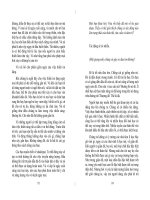Zoos and Animal Welfare Phần 5 docx
Bạn đang xem bản rút gọn của tài liệu. Xem và tải ngay bản đầy đủ của tài liệu tại đây (462.8 KB, 12 trang )
and Lowry Park Zoo captured 11 African elephants, a species
designated as threatened, from their natural habitats in
Swaziland. Experts, scientists, and researchers who study ele-
phants in the wild strongly opposed the capture, stating,
“Taking elephants from the wild is not only traumatic for them,
it is also detrimental to their health. . . . [W]e believe the
time has come to consider them as sentient beings and not as
so much money on the hoof to be captured and sold and dis-
played for our own use.”
Zoos are also pressuring the federal government to weaken the
Endangered Species Act to make it easier for them to capture and
import animals who are on the brink of extinction.
When Cute Little Babies Grow Up
Zoo babies are crowd-pleasers, but when they get older and
attract fewer visitors, many are sold or killed by zoos. Deer, tigers,
lions, and other animals who breed frequently are sometimes
sold to “game” farms where hunters pay for the “privilege” of
killing them; others are killed for their meat and/or hides. Other
“surplus” animals may be sold to circuses or smaller, more poor-
ly run zoos.
A chimpanzee named Edith is one example of a discarded zoo
baby who fell into the wrong hands. Born in the 1960s at the Saint
Louis Zoo, baby Edith was surely an adorable sight for visitors. But
just after her third birthday, she was taken from her family and
passed around to at least five different facilities, finally landing at
a Texas roadside zoo called the Amarillo Wildlife Refuge (AWR).
During an undercover investigation of AWR, PETA found Edith
in a filthy, barren concrete pit. She was hairless and had been liv-
ing on rotten produce and dog food. . . .
Another example involves Twiggs and Jeffrey, two giraffes born
at the Cape May County Zoo. When they got older, they were
sold by the zoo to a broker who subsequently sold them to a trav-
eling circus. The director of the Cape May County Zoo actually
admitted to seeing the animals’ pitiful living conditions in the
circus but did not have a problem with the situation.
48 Zoos and Animal Welfare
Zoos_ITCY_v5.qxd 11/5/07 5:31 PM Page 48
Zoos across the country sold animals to the now-closed New
Braunfels Zoo and continued to do so even after one of its own-
ers “quit in disgust at the animal neglect.” The director of an
Arizona zoo sold several exotic goats to a dealer who was known
to supply animals to trophy-hunting ranches.
Beyond Zoos
Ultimately, we will only save endangered species by preserving
their habitats and combating the reasons why they are killed by
people. Instead of supporting zoos, we should support groups like
the International Primate Protection League, the Born Free
Foundation, the African Wildlife Foundation, and other groups
Surplus Animals Are a Big Problem 49
Many animals in the wild have increased their numbers to the
point where hunting is sometimes needed to keep the animal
populations from starving.
Zoos_ITCY_v5.qxd 11/5/07 5:31 PM Page 49
that work to preserve habitats. We should help nonprofit sanctu-
aries that are accredited by The Association of Sanctuaries, such
as the Elephant Sanctuary and the Performing Animal Welfare
Society. These sanctuaries rescue and care for exotic animals with-
out selling or breeding them.
With all the informative television programming, our access to
the Internet, and the relative ease of international travel, learn-
ing about or viewing animals in their natural habitats can be as
simple as a flick of a switch or a hike up a mountain. The idea of
keeping animals confined behind cage bars is obsolete.
50 Zoos and Animal Welfare
Zoos_ITCY_v5.qxd 11/5/07 5:31 PM Page 50
Zoos understand that surplus animals are a problem, and they
are actively taking steps to reduce the number of animals
that are sold to private dealers and poorly run roadside zoos,
according to Jesse Donahue and Erik Trump in their book
The Politics of Zoos. According to the authors, the American
Association of Zoological Parks and Aquariums (AAZPA)
launched intensive investigations and generated a detailed
report that estimated the number of animals that end up as
“surplus.” Ultimately, the AAZPA established guidelines
designed to prohibit the sale of zoo animals to dealers who
sell to canned hunting ranches and roadside zoos and also
to ensure that other unwanted animals are euthanized in a
safe and humane manner. According to the authors, these
recommendations and guidelines ensure that individual ani-
mals are both cared for and respected. Jesse Donahue and
Erik Trump are both associate professors of political science
at Saginaw Valley State University.
T
he AZA [Association of Zoos and Aquariums] enjoyed legal
and legislative successes during the 1990s, but it waged a
much more difficult war internally and in the public relations
arena over the continuing problem of how zoos disposed of their
51
Surplus Animals Are
Being Dealt With
Jesse Donahue and Erik Trump
EIGHT
Jesse Donahue and Erik Trump, from The Politics of Zoos. DeKalb, IL: Northern Illinois University
Press, 2006. Copyright © 2006 by Northern Illinois University Press. All rights reserved. Used
with the permission of Northern Illinois University Press.
Zoos_ITCY_v5.qxd 11/5/07 5:31 PM Page 51
“surplus” animals. Zoos could proudly publicize their high stan-
dards of animal care, their conservation activities, and even their
successful breeding of endangered species, but they preferred to
keep silent about the fact that some of their unwanted animals
ended up dead or in the hands of incompetent caretakers. Animal
protectionists took every opportunity, however, to continue pub-
licizing this kind of animal “abuse” by zoos. Worse, concerned zoo
employees were going public about this dark side of the zoo, and
the AZA membership itself was divided about how to deal with
the issue. Slowly, the AZA developed a surplus animal policy, and
by the end of the decade it had begun to build some public cred-
ibility by lending visible support to efforts to restrict the private
ownership—and, by extension, abuse—of exotic pets.
Criticism of Zoos
As the decade opened, zoos again faced external and internal pres-
sure to address the surplus animal issue. Animal rights groups
began staging protests in front of zoos and aquariums and passing
out leaflets to build public awareness about the surplus problem.
The Friends of Animals, for example, sent the Oklahoma City
Zoo a leaflet titled “Zeroing in on Zoos” that it distributed out-
side of the zoos it picketed. All of its arguments against zoos focused
on the disposal of unwanted animals. The leaflet stated dramati-
cally that “almost every major zoo in the country is either con-
tributing to the problem or turning its back on it,” and it alleged
that even the prestigious San Diego Zoological Society sent a
Dybowski’s sika deer to a hunting ranch. In addition to confronting
protesters at their gates, zoos also faced internal criticism from
credible sources. In 1991, Donald Lindburg, the editor-in-chief of
Zoo Biology, wrote an editorial critical of the zoo surplus animal
problem, which Wagner distributed to the AAZPA board of
directors. It became difficult for the AAZPA to ignore the fact
that breeding programs were producing more animals than zoos
could exhibit and that the surplus animals were sometimes being
euthanized or sold to exotic animal dealers, eventually ending
up in the hands of private owners, roadside zoos, or even hunt-
52 Zoos and Animal Welfare
Zoos_ITCY_v5.qxd 11/5/07 5:31 PM Page 52
ing ranches. The AAZPA had tackled the surplus issue in the
1970s and again in the 1980s, but it appeared to be a problem
with no easy solution.
Addressing the Problem
To address this growing problem, the AAZPA formed a surplus
animal fact-finding committee in 1990. The committee’s result-
ing report focused on the place of euthanasia in the dealing with
unwanted animals. The report illustrated at least some of the
AAZPA’s understanding of when euthanasia should be employed,
the uncertainty zoo members themselves felt about the issue, what
they thought they should do about the problem, the trouble that
zoos members had sympathizing with animal protection groups
on the issue, and their strategy for managing the public relations
difficulties that accompanied killing zoo animals.
The report confirmed that zoo animals were in fact ending up
as pets or on hunting ranches. Using ISIS data (an animal reg-
istry system for zoos), the authors calculated the number of ani-
mals “removed” from zoos. Although their estimates were rough,
because not all AAZPA accredited institutions participated in the
ISIS system, they indicated that as many as 5 percent of all zoo
animals were removed from their homes each year. Most of these
animals went to other zoos, but the authors concluded that a sig-
nificant number of animals ended up in the hands of private deal-
ers and individuals. On the basis of their findings, they made sug-
gestions for surplus animal guidelines that included increased
education about the issue and an agreement between each zoo
and those who took their animals. This agreement would control
what happened to the animals in subsequent transactions by pro-
hibiting the new owner from selling them to an inhumane research
program, allowing them to be hunted, or selling them to people
who were suspected of animal abuse. The report also offered rec-
ommendations about how zoos could keep most animals out of the
hands of private citizens and hunting institutions: use birth con-
trol, separate the sexes, give the animals to another qualified zoo,
sell to an accredited dealer, or give them to regulatory agencies for
Surplus Animals Are Being Dealt With 53
Zoos_ITCY_v5.qxd 11/5/07 5:31 PM Page 53
reintroduction. Although zoos hoped to send some animals back
to the wild, the authors did not anticipate being able to do this
often for “the next century or two.” There were a few animals
that fell into a “gray area” between pets and wildlife that the
report indicated might be confidently sold back to the public
54 Zoos and Animal Welfare
A rare white tiger cub plays in a public display area. The
American Association of Zoological Parks and Aquariums is
working to ensure that surplus animals are not sold to canned
hunting ranches and roadside attractions.
Zoos_ITCY_v5.qxd 11/5/07 5:31 PM Page 54
through reputable animal dealers. As a last resort the report rec-
ommended using euthanasia, the most controversial method of
animal disposal.
Euthanasia for Surplus Animals
The report suggested conditions under which euthanasia might
be employed. Notably absent was the condition of an aggressive
temperament as had been the case for one of the Detroit Zoo’s
Siberian tigers. Instead, the recommendations centered on poor
health and population management. For example, the report
approved of euthanasia in the cases where “animals receiving med-
ical attention do not respond to treatment,” “animals cannot carry
out minimal biological functions,” or “animals [have] no realistic
chance of survival.” At the same time, it reminded its readers that
a commitment to saving species required preserving the gene pools,
which had to be “managed” so that the surplus animals whose
genes were redundant did not “deprive” other animals of a place
on the “captive-ark.” At least some of these euthanized animals
might make appropriate food for other animals in the facility.
The internal political problem, the report acknowledged, was
that not everyone within a given zoo supported euthanasia. The
report noted that, because zoo keepers often developed an “emo-
tional rapport” with the individual animals for which they cared,
they were particularly reluctant to approve of euthanasia. The
report noted that keepers agreed with euthanasia in theory as a
means to “manage genetic diversity,” but they often objected to
it in practice. As a result, the report recommended educating both
keepers and volunteers whose “sentimental involvement may be
even more of a motivation” for their job. As the Detroit tiger case
showed, unhappy zoo employees were more than a hypothetical
possibility.
In addition to identifying problems with zoos’ own employees,
the report detailed the public’s substantial resistance to euthana-
sia. Zoos unintentionally heightened the public’s emotional feel-
ings about animals with their “adopt an animal” fund-raising pro-
grams in the 1980s that encouraged citizens to believe that they
Surplus Animals Are Being Dealt With 55
Zoos_ITCY_v5.qxd 11/5/07 5:31 PM Page 55
owned a particular animal. Thus, the report recommended doing
away with these programs, “de-emphasizing individual animals and
. . . addressing species as a whole.” Doing so would help the pub-
lic, which the report described as “lack[ing] information and under-
standing of animals,” accept euthanasia. Animal enthusiasts, the
report continued, had “limited intellectual and ecological under-
standing of animals, with a very high humanistic attitude.”
In addition to taking away animals’ names and separating donors
from animals, the report also recommended an elaborate plan to
manage the potential public relations disaster lurking in every
euthanasia decision. It advised careful documentation of why a
particular animal was “surplus” through reference to its genetic
redundancy. Following that, it suggested gathering keepers and
other zoo professionals together for a meeting and handing out the
AAZPA surplus guidelines and other reference materials on
euthanasia. To head off criticism from public authorities such as
city councils, which often had governing authority over the ani-
mals, the report recommended “stressing the risks of disposing . . .
surplus animals to unqualified recipients and the negative long-
range effects of excessive birth control upon the survival of endan-
gered species.” In short, the report recognized, as the judge in
Detroit’s tiger case had opined, that euthanasia decisions were ulti-
mately political.
Conflicting Viewpoints on Surplus Animals
As public institutions, zoos would have to generate public under-
standing of their policies, yet the issues related to surplus animals
remained contentious, even within the zoo community. These
divisions were clearly visible at a 1993 AAZPA forum on surplus
animals and hunting. On the one hand, some members resisted
any accommodation on the issue, defending zoos’ right to dispose
of animals in any manner they saw fit, including sales to hunting
ranches. One member noted that zoos were regulated by the
USDA and wondered, “why should zoo animals be legally con-
sidered different from any other form of livestock?” A more mod-
erate voice put the issue in the context of political attacks on zoos,
arguing that zoos should “seek a position that would provide for
56 Zoos and Animal Welfare
Zoos_ITCY_v5.qxd 11/5/07 5:31 PM Page 56
a management policy based upon conservation principles, rather
than . . . one which appears merely to serve the animal rights
agenda.” Speakers on this side expressed unease about maintain-
ing responsibility for animals once they left a zoo’s gates. On the
other hand, some members insisted that zoos should care about
the fate of all animals, not just those in their immediate care. The
antihunting faction within the AAZPA argued that the AAZPA’s
philosophical support for the sustainable harvesting of natural
resources did not include “taking a zoo-raised animal, putting it
in a crate and allowing someone to shoot it as it is released.” Others
reminded their fellow members that zoos gained little political
benefit from supporting game ranches: “why does the AAZPA
want to be associated with these people?”. . .
Protecting the Animals
The AAZPA board ultimately came down on the side of those
members who wanted to protect individual animals. In its policy
statement about the disposition of animals to hunting organiza-
tions, it reminded its members that zoo animals are “held in pub-
lic trust” by largely public, taxpayer-supported institutions and
that the public certainly did not imagine that its zoos were breed-
ing animals for big-game hunters. Though they noted that some
conservation policy involved culling, they stated that sending
wildlife to hunting ranches impugned the role of zoos “as sensi-
tive guardians and conservators.” Just as zoos’ public status guar-
anteed them some legal protections, it also obligated them to be
at least somewhat responsive to popular opinion.
Ultimately the AAZPA was able to resolve the surplus issue as
it related to hunting ranches and embarked on a campaign with
animal protection groups aimed at curtailing exotic pet ownership.
Surplus Animals Are Being Dealt With 57
Zoos_ITCY_v5.qxd 11/5/07 5:31 PM Page 57
Zoos play a key role in education, according to the Wildlife
Conservation Society, an organization that saves wildlife
worldwide. In conjunction with the Bronx Zoo, the Wildlife
Conservation Society implements education initiatives serv-
ing teachers, students, and the general public. With dis-
tance learning programs, science education activities, hands-
on learning opportunities, and outreach campaigns, the
organization strives to teach the importance of zoo life. The
Wildlife Conservation Society aims to save wildlife through
science, global conservation, education, and the manage-
ment of the world’s largest system of urban wildlife parks
led by the flagship Bronx Zoo.
E
ducation has been a cardinal tenet of the WCS [Wildlife
Conservation Society] mission since its inception in 1895.
Today, the Education Division supports the science literacy of
teachers nationwide, bolstering the capacity of international envi-
ronmental educators on several continents, and enhancing the
eco-literacy of families and children in the boroughs of New York
City and the tri-state area. By raising conservation awareness and
providing tools for conservation action, the Education Division
58
Wildlife Conservation Society
NINE
Zoos Play a Key Role
in Education
Wildlife Conservation Society, from Wildlife Conservation Society Annual Report. Bronx, NY: Wildlife
Conservation Society, 2006. Copyright © Wildlife Conservation Society, 2006. All rights reserved.
Reproduced by permission.
Zoos_ITCY_v5.qxd 11/5/07 5:31 PM Page 58
is preparing the next generation of conservation educators and
action-oriented citizens. . . .
Zoos Teach from a Distance
During the past five years, the WCS Education Division has cre-
ated a stellar interactive videoconference program for school class-
rooms. Developed with funding from the U.S. Department of
Education and Lucent Technologies Foundation, Distance Learning
Expeditions uses . . . the Internet to bring live broadcasts to stu-
dents from New York to California and from Mexico to Great
Britain. Many of these students have no access to a zoo locally.
The Distance Learning Expeditions feature 50-minute video-
conferences, as well as pre- and post-videoconference materials,
to teach students about wildlife conservation and ecology. A “One
WCS” exemplar, the program uses the organization’s world-
renowned scientific and environmental education resources. In
addition, viewers have access via remote-controlled cameras to
the Bronx Zoo’s unparalleled collections of live animals, as well
as its award-winning curricula and scientific field research.
According to an independent evaluation, “In all measures of use
and effectiveness, the Distance Learning Expeditions program is
positively rated.” During the past school year, the program pro-
vided videoconferences for nearly 8,000 students in 15 states, with
604 teachers participating.
Tori Howe, a student from Maine, said that she likes the fact that
she doesn’t have to leave the classroom to see the Zoo. Unlike a
TV show or a Web site, “You can ask questions,” she said. Jill Bell,
her teacher, said that her students, “are accessing a primary source,”
despite the fact that the school is miles from the nearest zoo. . . .
Zoos and Science Education
Programming for city and area schools continues to be vital to the
science education of thousands of elementary and high school stu-
dents. There is growing consensus that quality programming dur-
ing after-school hours prevents risky behavior and keeps kids safe.
This year, City cultural institutions linked with Department of
Zoos Play a Key Role in Education 59
Zoos_ITCY_v5.qxd 11/5/07 5:31 PM Page 59
